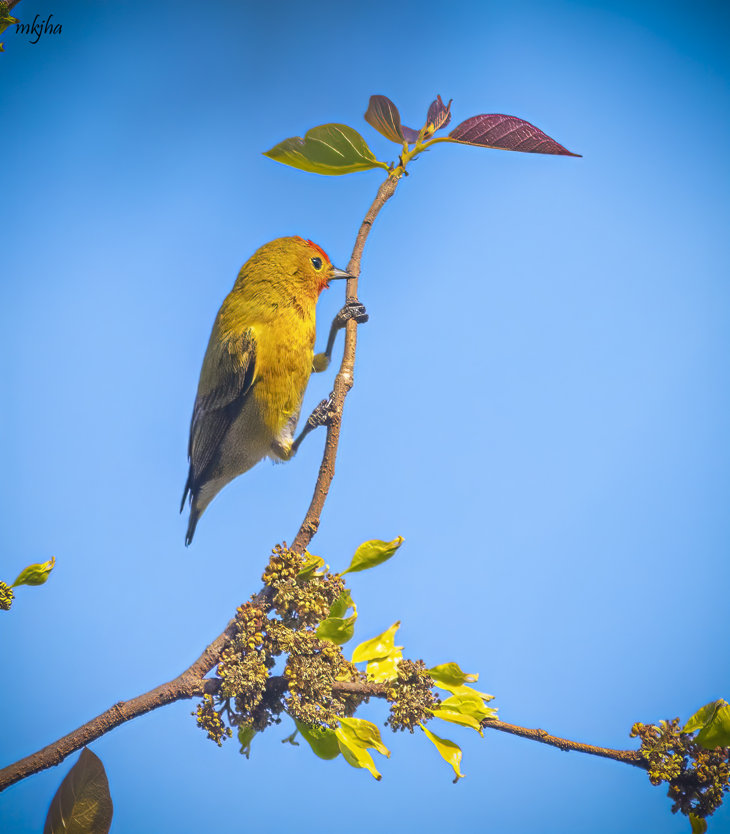The fire-capped tit was perched on the topmost branch of the tree and it was so restless. It is like a heavy work bird – busy all the time. He does not have the time to sit in silence or inactivity.
We were following a media report that a flock of fire-capped tits were sighted in Bhondsi in Gurgaon, in Haryana after decades. Experts said it was last seen in the National Capital Region in 1980 and before that it was spotted only in 1957.
My photographer friends told me that a flock of the fire-capped tit is back again, for the second consecutive year. Seems they liked the place during the lockdown.

A female fire-capped tit (Photo: Mrityunjoy Kumar Jha)
According to experts, this species is known for seasonal migration from high to lower altitudes during winter, where birds breeding at the foothills of the Himalayas can migrate all the way to North-Central India and northern Thailand. Fire-Capped tits are native to the Himalayan mountain range, where they nest at altitudes of about 6,000 feet. During the winter, however, they descend to the foothills and plains adjoining the Himalayas and head back into the mountains sometime after March.
So we decided to try our luck and reached Bhondsi one early morning of March this year.
Bhondsi became famous when former Prime Minister Chandrashekhar came to live here in 1991. He set up a trust here to focus on rural development. After his demise, the trust and the park spread over 588 acres in the Aravalli mountain range, was acquired by the Haryana government to set up a nature park. Located on the foothills of the Aravallis, along the Sohna road and close to the Damdama Lake, the park provides city dwellers with a perfect weekend getaway to connect with nature.
We were looking for our target species in the vast jungle of Bhondsi. After three hours of hard exploration, we decided to call off the search but our team leader decided to try out his luck one more time and finally that hard work paid off.
“It is so small… even smaller than a sparrow,” I thought but why is it called a fire-capped tit?
“Focus on pictures now…” I was told.

A female fire-capped tit (Photo: Mrityunjoy Kumar Jha)
There was a big flock and the forest reverberated with their 'twitchable' sound. The flock showed its activities exceptionally well for the next hour or so, feeding constantly, pecking flower fruits. It was seemingly oblivious to our presence below the tree. These birds are also called as ‘Chickadees’ which is derived from their distinctive ‘chick-a dee dee dee’ alarm call.
It was breeding season for the species and male had a slight orange-scarlet colored crest. The eyebrow and around the eye is golden yellow tinged with red. The cheeks, ear coverts and sides of the neck are olive-yellow. The chin and upper throat are orange chrome, melting into golden yellow chest. The sides of the chest and the upper sides are yellow-olive. The rear flanks and belly are pale yellow. What a beautiful bird!
According to eBird website, more of a soft blush than a burning flame, the red patch on the male’s face is nonetheless unique. The female lacks the red patch, but is still distinctive in her size, small sharp bill, and pale wingbars. Both sexes are yellow above and pale gray below, with the male being more predominantly yellow than the female. The female is duller and bright orange colour was missing in them. The female lacks the red patch, but is still distinctive in her size, small sharp bill, and pale wingbars.
Their song is an undulating series of twitters, chips, and trills; also twitters and trills when flocking. Their calls include a high-pitched but ample and jerky "tsit-tsit-tsit-tsit" at irregular intervals. Their contact call is a soft and low "whitoo-whitoo".

A male fire-capped tit (Photo: Mrityunjoy Kumar Jha)
When singing, the male flies or sits on a high well exposed spot like the top of a tree. The song lasts several minutes. It consists of a series of rapid, high notes, forming well-constructed sentences, "pit'su-pit'su-pit'su-pit'su".
I was told the fire-capped tit (Cephalopyrus flammiceps ) was once considered to be a kinglet but is today treated as a tit. The tits are generalist insectivores that consume a wide range of small insects and other invertebrates, particularly small defoliating caterpillars. They also consume seeds and nuts, especially in the winter. One characteristic method of foraging in the family is hanging, where they will inspect a branch or twig and leaves from all angles while hanging upside down to feed.
In Bangla this species is known as Sindur Sinthi Titpakh and I tried to find out what is the Hindi name but without any success.
The fire-capped tit is classified as a ‘least concern’ (LC) species by the International Union for Conservation of Nature (IUCN), which means that its risk of extinction has been evaluated without much worry but apart from that not much study has been done about this species.
Hopefully fire-capped tit will come back again next year, at the same time, at the same place.




















